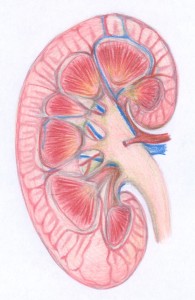GFR Calculations- Accepted formula
Estimated values
A number of formulae have been devised to estimate GFR or Ccr values on the basis of serum creatinine levels.

Estimated creatinine clearance rate (eCCr) using Cockcroft-Gault formula
A commonly used surrogate marker for estimate of creatinine clearance is the Cockcroft-Gault formula, which in turn estimates GFR: It is named after the scientists who first published the formula, and it employs serum creatinine measurements and a patient’s weight to predict the creatinine clearance. The formula, as originally published, is:
![eC_{Cr} = \frac { \mbox{(140 - Age)} \ \times \ \mbox{Mass (in kilograms)} \ \times \ [{0.85\ if\ Female}]} {\mbox{72} \ \times \ \mbox{Serum Creatinine (in mg/dL)}}](http://upload.wikimedia.org/math/4/6/e/46e61afd39d2a3acc66f456c33392c9e.png)
- This formula expects weight to be measured in kilograms and creatinine to be measured in mg/dL, as is standard in the USA. The resulting value is multiplied by a constant of 0.85 if the patient is female. This formula is useful because the calculations are simple and can often be performed without the aid of a calculator.
When serum creatinine is measured in micromol/L:
One interesting feature of the Cockcroft and Gault equation is that is shows how dependent the estimation of CCr is based on age. The age term is (140 – age). This means that a 20-year-old person (140-20 = 120) will have twice the creatinine clearance as an 80-year old (140-80 = 60) for the same level of serum creatinine (120 is twice as great as 60). The C-G equation also shows that a woman will have a 15% lower creatinine clearance than a man at the same level of serum creatinine.
Estimated GFR (eGFR) using Modification of Diet in Renal Disease (MDRD) formula
The most recently advocated formula for calculating the GFR is the one that was developed by the Modification of Diet in Renal Disease Study Group.Most laboratories in Australia and The United Kingdom now calculate and report the MDRD estimated GFR along with creatinine measurements and this forms the basis of Chronic kidney disease#Staging.The adoption of the automatic reporting of MDRD-eGFR has been widely criticised.
The most commonly used formula is the “4-variable MDRD” which estimates GFR using four variables: serum creatinine, age, race, and gender. The original MDRD used six variables with the additional variables being the blood urea nitrogen and albumin levels. The equations have been validated in patients with chronic kidney disease; however both versions underestimate the GFR in healthy patients with GFRs over 60 mL/min. The equations have not been validated in acute renal failure.
For creatinine in mg/dL: < Click on formula to enlarge >
For creatinine in mol/L:
![\mbox{eGFR} = \mbox{32788}\ \times \ \mbox{Serum Creatinine}^{-1.154} \ \times \ \mbox{Age}^{-0.203} \ \times \ {[1.210\ if\ Black]} \ \times \ {[0.742\ if\ Female]}](http://upload.wikimedia.org/math/4/c/2/4c2d711d7880ba074e3b762e606cf972.png)
- Creatinine levels in mol/L can be converted to mg/dL by dividing them by 88.4. The 32788 number above is equal to 18688.41.154.
A more elaborate version of the MDRD equation also includes serum albumin and blood urea nitrogen (BUN) levels:
![\mbox{eGFR} = \mbox{170}\ \times \ \mbox{Serum Creatinine}^{-0.999} \ \times \ \mbox{Age}^{-0.176} \ \times \ {[0.762\ if\ Female]} \ \times \ {[1.180\ if\ Black]} \ \times \ \mbox{BUN}^{-0.170} \ \times \ \mbox{Albumin}^{+0.318}](http://upload.wikimedia.org/math/7/2/7/727fb222d37012663ab0c148d375dba6.png)
- <Click on formula to enlarge>
- Where the creatinine and blood urea nitrogen concentrations are both in mg/dL. The albumin concentration is in g/dL.
These MDRD equations are to be used only if the laboratory has NOT calibrated its serum creatinine measurements to isotope dilution mass spectroscopy (IDMS). When IDMS-calibrated serum creatinine is used (which is about 6% lower), the above equations should be multiplied by 175/186 or by 0.94086. See:
Since these formulae do not adjust for body mass, they (relative to the Cockcroft-Gault formula) underestimate eGFR for heavy people and overestimate it for underweight people. (see Cockcroft-Gault formula above).
Estimated GFR (eGFR) using the CKD-EPI formula
The CKD-EPI (Chronic Kidney Disease Epidemiology Collaboration) formula was published in May 2009. It was developed in an effort to create a formula more precise than the MDRD formula, especially when actual GFR is greater than 60 mL/min per 1.73 m2.
Researchers pooled data from multiple studies to develop and validate this new equation. They randomly divided 10 studies which included 8254 participants, into separate data sets for development and internal validation. 16 additional studies, which included 3896 participants, were used for external validation.
The CKD-EPI equation performed better than the MDRD (Modification of Diet in Renal Disease Study) equation, especially at higher GFR, with less bias and greater accuracy. When looking at NHANES (National Health and Nutrition Examination Survey) data, the median estimated GFR was 94.5 mL/min per 1.73 m2 vs. 85.0 mL/min per 1.73 m2, and the prevalence of chronic kidney disease was 11.5% versus 13.1%.
The CKD-EPI equation, expressed as a single equation, is:
where SCr is serum creatinine (mg/dL), k is 0.7 for females and 0.9 for males, a is -0.329 for females and -0.411 for males, min indicates the minimum of SCr/k or 1, and max indicates the maximum of SCr/k or 1.
A clearer version may be as follows: For creatinine (IDMS calibrated) in mg/dL:
African American Female
If serum creatinine (Scr) <= 0.7
If serum creatinine (Scr) > 0.7
African American Male
If serum creatinine (Scr) <= 0.9
If serum creatinine (Scr) > 0.9
White or other race Female
If serum creatinine (Scr) <= 0.7
If serum creatinine (Scr) > 0.7
White or other race Male
If serum creatinine (Scr) <= 0.9
If serum creatinine (Scr) > 0.9
This formula was developed by Levey et al.
Estimated GFR (eGFR) using the Mayo Quadratic formula
Another estimation tool to calculate GFR is the Mayo Quadratic formula. This formula was developed by Rule et al. in an attempt to better estimate GFR in patients with preserved kidney function. It is well recognized that the MDRD formula tends to underestimate GFR in patients with preserved kidney function.
The equation is: GFR = exp(1.911 + 5.249/SCr – 2.14/Scr^2 – 0.00686 * Age -0.205 (if female))
If SCr < 0.8 mg/dL, use 0.8 for SCr
Estimated GFR for children using Schwartz formula
In children, the Schwartz formula is used. This employs the serum creatinine (mg/dL), the child’s height (cm) and a constant to estimate the glomerular filtration rate:

- Where k is a constant that depends on muscle mass, which itself varies with a child’s age:
- In first year of life, for pre-term babies K=0.33 and for full-term infants K=0.45
- For infants between ages of 1 and 12 years, K=0.55
The method of selection of the K-constant value has been questioned as being dependent upon the gold-standard of renal function used (i.e. creatinine clearance, inulin clearance etc) and also may be dependent upon the urinary flow rate at the time of measurement.
Importance of calibration of the serumcreatinine level and the IDMS standardization effort
One problem with any creatinine-based equation for GFR is that the methods used to assay creatinine in the blood differ widely in their susceptibility to non-specific chromogens, which cause the creatinine value to be overestimated. In particular, the MDRD equation was derived using serum creatinine measurements which had this problem. The NKDEP program in the United States has attempted to solve this problem by trying to get all laboratories to calibrate their measures of creatinine to a “gold standard”, which in this case is isotope dilution mass spectroscopy (IDMS). At the present time in late 2009 not all labs in the U.S. have changed over to the new system. There are two forms of the MDRD equation that are available, depending on whether or not creatinine was measured by an IDMS-calibrated assay. The CKD-EPI equation is designed to be used with IDMS-calibrated serum creatinine values only.
Cystatin Problem with creatinine (varying muscle mass, recent meat ingestion, etc.) have led to evaluation of alternative agents for estimation of GFR. One of these is cystatin C, a ubiquitous protein secreted by most cells in the body (it is an inhibitor of cysteine protease) that is freely filtered at the glomerulus and not reabsorbed. After filtration, cystatin C is normally catabolized in the renal tubules and none appears in the urine, so urine collection methods cannot be used. However, equations have been developed linking estimated GFR to serum cystatin C levels. Most recently (2009) some proposed equations have combined creatinine and cystatin. None are available clinically at this time, but this is likely to change in the near future.
Normal ranges
The normal range of GFR, adjusted for body surface area, is similar in men and women, and is in the range of 100-130 ml/min/1.73M2. In children, GFR measured by inulin clearance remains close to about 110 ml/min/1.73M2 down to about 2 years of age in both sexes, and then it progressively decreases. After age 40, GFR decreases progressively with age, by about 0.4 – 1.2 mL/min per year.













